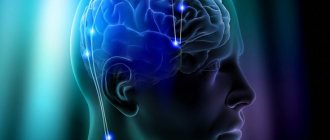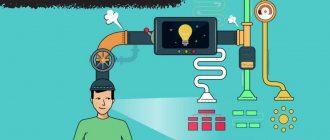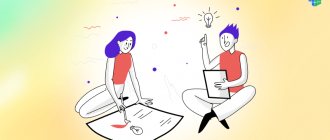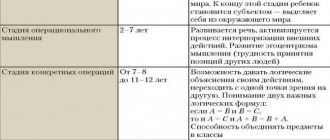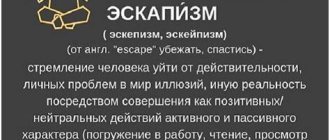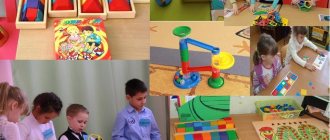Definition 1
Technology for the development of critical thinking is methods and techniques aimed at developing mental work skills (planning, forecasting, self-esteem, self-regulation) required for the implementation of the life activities of any individual.
Definition 2
Critical thinking is the correlation of one’s knowledge with those circumstances of the external world that require making a specific decision and taking active action.
This kind of thinking helps one navigate huge amounts of information resources and act in accordance with specific information.
The development of critical thinking is very important for any person, since it is the foundation for the development of an individual’s creative potential. Critical and creative thinking are formed in parallel: in interconnection and interaction.
Are you an expert in this subject area? We invite you to become the author of the Directory Working Conditions
What is critical thinking technology?
The technology of critical thinking is used in psychology, pedagogy, philosophy, literature, journalism and other fields as the foundation for the development of thinking skills, the ability to make informed decisions, argue one’s position, and think purposefully.
Critical thinking as an educational technology is aimed at developing the following skills in students:
- observation;
- analysis;
- synthesis;
- deduction;
- induction;
- interpretation;
- observation;
- logical judgment;
- reasoning from abstraction to specificity.
Definition of the concept
Critical thinking is a person’s ability to effectively analyze incoming information and defend one’s opinion in a reasoned manner, understand the position of a communication partner, competently formulate conclusions and make the only correct decision based on initial data. It characterizes a person as an active subject of educational activities in an educational institution, and not just a passive recipient of dry information. It makes the employee a truly valuable person for the enterprise, since it implies the ability to reason. A person's ability to think clearly combines logic and critical thinking. In the absence of critical thinking, it is impossible to develop basic skills of self-analysis and reflection in a person. Such an individual will not learn from his mistakes and recall the experience of the past in an incomprehensible situation.
Based on the definition, we can conclude that signs of its presence in an individual are:
- the ability to establish cause-and-effect relationships between events and people’s emotional reactions;
- understanding the patterns of historical events;
- the ability to select from a variety of facts and theses those that are necessary to solve a specific situation;
- the ability to recall personal experiences (both positive and negative) in a stressful situation;
- tolerance to other people's opinions and life principles of another person;
- the ability to take criticism constructively;
- the ability to cogently express one’s thoughts in dialogue;
- the ability to notice contradictions and inconsistencies in the interlocutor’s statements;
- consistency and goodwill in resolving controversial issues and conflict situations;
- tendency to resolve conflicts peacefully;
- rejection of stereotyped options for action and stereotypical thinking;
- self-actualization;
- the ability for self-analysis and the need for continuous self-development and self-improvement.
What does this give?
The main value of the technology of critical thinking and its techniques is the ability to objectively perceive information, not to take what is seen and heard on faith, the right to doubt, to assume, to perceive it as a hypothesis requiring evidence.
It is impossible to manipulate and control a person who has developed critical thinking, because he thinks purposefully and can adequately assess any situation.
Other advantages include:
- professional guidance and self-determination;
- clear prioritization;
- responsibility for one's own decisions and choices;
- the ability to predict the consequences of decisions;
- communication characteristics;
- formation of a stable value system.
Why develop this ability?
The ability to reason rationally is an integral component of various spheres of human life in society.
- Educational activities. This feature of mental activity helps a schoolchild or student independently select the necessary scientific and methodological literature for writing an essay or term paper and structure the text of theoretical primary sources, helps to reveal the cause-and-effect relationships of phenomena and processes of the surrounding reality. During lessons, seminars and practical exercises, students with developed fundamentals of critical thinking argue their point of view, take an active part in discussions, and are leaders in the team.
The principles of criticality and prudence are in demand in such sciences as philosophy, social science, history, political science, sociology, psychology and pedagogy. The higher the level of development of mental operations of a school student or college student, the higher his grades.
- Sphere of professional work. At many enterprises, employees must not only know standard process flow diagrams, but also be able to make non-standard decisions. This is a sought-after ability for such professions as engineer, designer, manager, repairman, doctor. Key critical thinking skills are recorded in profession plans.
According to Agapov, critical thinking is a professionally significant trait of any leader, which underlies the ability to see problems comprehensively and make fateful decisions in conditions of a lack of information.
- Everyday life. Each of us has to decide issues regarding our studies, work, career, personal life and health. Psychologists have found that critical consciousness helps people recognize lies in the words of their interlocutor and tactfully point them out to him, be convincing in a heated argument, successfully and promptly resolve family conflicts, and maintain mutual understanding with loved ones.
Experts in the field of psychology believe that the demand for critical thinking today is due to scientific and technological progress. Associated with this is the ever-increasing amount of information that a person encounters every day. A modern resident of a metropolis needs to be able to “filter” information.
Critical thinking can develop the following qualities in a person:
- resourcefulness and intelligence;
- speed reaction;
- Analytical mind;
- rationality and consistency;
- balance of character;
- stress resistance and tact;
- tolerance and tolerance;
- self-awareness;
- creativity.
Insert
The Insert or conditional technique is usually used during the call phase. The teacher invites students to make notes with a pencil while reading the text.
The following symbols are marked:
- new knowledge;
- familiar things;
- information that contradicts the student’s understanding;
- points on which the student wants to deepen knowledge.
Readers then create a four-column table. The column name is a symbol for the text. In each column you need to briefly write down information from the text, then re-read what you wrote and add new thoughts and doubts.
The table is a visualization of the path from old to new knowledge. This technique helps to systematize the thought process, correctly classify information, highlighting new information from it and remembering it more easily.
Origin of the term
The idea of critical thinking dates back to ancient times. It comes from the work of Socrates, who 2500 years ago declared: no one can depend on authorities. After all, they can behave far from rationally. Deep questions must be raised about the emergence of an idea before it can be trusted. Socrates proved that the search for evidence is very important. The most popular method of teaching critical thinking is “Socratic questioning,” which brings clarity and logic.
The practice of Socrates and the skepticism of Aristotle were developed by Plato. A tradition has emerged of thinking systematically on the path to comprehending deep realities. Skepticism arose in the writings of philosophers of the Middle Ages and the Renaissance. The profundity of antiquity was developed by them. Methods for developing critical thinking have evolved into an understanding of the power of information, the importance of its careful collection, and proper use. And the resources of this mindset have been multiplied by the contributions of many thinkers.
Creating a cluster
Cluster is translated as a bunch, a bunch. In the technology of critical thinking, this technique is used as a graphic systematization of material on a specific problem.
Semantic units are highlighted in the text using graphic symbols, and then arranged in a hierarchy or in another order. As a result, clusters are formed.
The rules for composing clusters are simple: the main topic is placed in the center, surrounded by semantic units that deserve attention. Next to them are satellite words. Logical connections are shown as lines between key concepts.
In fact, the result is a diagram of circles connected to each other by straight lines or arrows. The value of this method is that it allows you to cover and analyze a larger amount of information than when reading and analyzing from a sheet.
The cluster system is a graphical display of the user’s thoughts, ideas, doubts, and logical conclusions. Clusters are used at the stages of challenge and reflection and are suitable for studying various topics.
How to take classes?
Mastering critical thinking professionally can be difficult. If initially thinking obeyed other laws and followed habits, restructuring it in a new way causes rejection and discomfort. But if there is a clear goal and you are determined to achieve your goal, it is important to be persistent and use all available means. Our course will be one of the most effective among them.
We have already mentioned that the material presented is theoretical and practical in nature. This means that there is certain information that needs to be read, studied and absorbed - and here everything is extremely simple. And there is a certain amount of practical recommendations - with them everything is a little more complicated. Practical knowledge needs to be transferred to the field of action as soon as possible so that new skills begin to be formed and consolidated faster. Practice is the cornerstone of any learning, and you should always remember this.
You can complete the classes in the way that is most convenient for you, but we still advise you to follow the existing sequence. It is best to allocate 2-3 days to study each lesson, of which one will be allocated for reading, the second for repeating the most important points, and the third for the practical application of knowledge.
Let us not fail to note that it is the third day that is of greatest importance, because theory without practice is just a baggage of information that has no real use. Actions, even in cases where they are not supported by theory, always lead to a result, albeit not always to the desired one. But you have everything you need, so you can be sure that the result will be appropriate.
We also note that it is useful to combine teaching critical thinking in the lessons of our course with the use of auxiliary materials, which in our case are books. Below we offer you a small list of relevant literature.
Carousel
The carousel is a technique for group work; in critical thinking technology it is used to work through open-ended questions. Before the discussion, the teacher formulates problematic questions that require multiple answers on separate sheets of paper. The number of questions must correspond to the number of groups.
On command, the teachers pass sheets of questions clockwise to each group member - like a carousel. The purpose of the technique is to jointly find an answer without duplicating previously voiced versions.
Then the teacher posts the groups’ answers on the board and announces a vote. Students vote for the answer that seems most accurate to them.
My recommendations
Once at a personal growth training, one of the teenagers explained in his own words what critical thinking is: this is the ability of an individual to have his own opinion regarding everything that happens around him. Observing teenagers' group work gave me insight into how to develop critical thinking. I have compiled my thoughts on this matter in the form of a memo that I give to teenagers when I am invited to themed classes at schools.
- You need to constantly engage in self-development: watch documentaries and discuss them with friends or relatives, read books of different genres, master new activities and try yourself in various areas of arts and crafts and technical creativity. Critical thinking is characterized by a comprehensive study of the issue, which requires the individual to have knowledge in a variety of fields of science. During the processing of information entering the brain, the development of various components of critical thinking occurs.
- When studying any theoretical issue, use not only books and articles recommended by the teacher, but also alternative sources of information: thematic forums on the Internet, webinars and interviews with famous people. Critical thinking develops in the course of formulating its overall definition of a particular term based on the interpretations of this concept by different researchers.
- Analyze people's behavior in different situations. Critical thinking includes not only the ability to reflect, but also an understanding of the reasons for certain behavioral reactions of others. Knowledge in the field of social psychology helps to build effective interaction with almost any person. Of course, to succeed in this business you will also need developed communication skills.
- How can an adult develop critical thinking? Help him develop self-control skills. An example of critical thinking in a person’s life is the habit of thinking about the consequences of one’s actions.
- When faced with a problematic situation, try to come up with several options for resolving it that completely suit you. The ability to choose the most optimal one from several options is an indicator of a developed analytical mind.
- Make the most of mistakes. A sign of a person’s lack of critical thinking is his refusal to continue activities at the first failure. In psychology, mistakes are factors and driving forces of development. Everyone makes mistakes, but not everyone knows how to handle them correctly. To get the maximum benefit from an error, you need to carefully analyze it, establish the reasons for its occurrence, and think about ways to eliminate it in the future.
- There is no need to be embarrassed to ask something from a stranger. The inability to ask questions is a sign of a lack of critical thinking. You can do a self-test: can you come up with 50 questions for your interlocutor about his favorite book?
- Exercises and games with words. To develop your critical thinking skills, you can organize word games in the company of friends, since everything difficult in the game is easier. For example, you can choose an object in the room (for example, a comb or a ruler) and try to come up with as many creative ways to use this thing as possible. Or formulate a question and then associate a random word found on a page in a book with it.
Reading with pauses
This technique involves measured reading of the text. The teacher reads part of the story aloud, pauses and asks a problematic question to the audience. Questions can be about associations, feelings, further development of the storyline, the ending of the story, but each of them should encourage the group to search for an answer and discuss.
Discussions are held in pauses, after which the teacher reads the next part of the text and breaks again.
Cross discussion
This method is similar to the previous one in that it involves searching for answers to questions based on a read fragment of a work. Students work in pairs with opposing opinions.
The first pair expresses a version and gives arguments in its favor, the second pair voices counterarguments and substantiates them. The task of technology is to work through the maximum number of versions, express different points of view and look at the situation from different angles.
During the discussion, students can move from one pair to another if their opinion has changed.
Sinkwine
Cinquain translated from French means five lines. Compiling it is an effective mental exercise. It develops the skills of concise summarizing after comprehending the material covered.
The task of the practitioners is to write 5 lines:
- One noun that states the topic.
- Two adjectives that clarify the topic.
- Three verbs describing actions on the topic.
- A short phrase that contains the main idea.
- A summary that has an unexpected twist, the user’s attitude to the topic, and a fresh interpretation of it.
Theory and practice require teachers and students to persevere, adequately perceive the opinions of others, and be willing to admit their own mistakes, draw conclusions and correct them. Without this there will be no progress.

